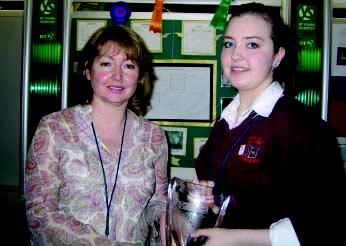| 2006 |

|
YEAR BOOK |
Rosses Community School, Co Donegal
|
Bio-filtration system purifying waste water
|

� Bottled drinking water
� Donegal County Council treated water
� Water from a 'shop bought' treatment system.As the project progressed and I began my research, I became engrossed in the various waste water purification systems installed in my locality and systems available worldwide. As I live in a rural part of the country, it became clear to me just how important the septic tank at the bottom of the garden is.
The willow tree bio-filtration system operates as follows:
1. Domestic sewage is pumped to a solids separator, in which the solids are separated from the liquid effluent. The solids are then treated with worms to form compost.
2. The liquid effluent is pumped through a series of wetlands, in which willow trees ( Salix alba - White Willow) are planted.
3. The roots of the willow use the nutrients from the effluent e.g. nitrate as food; and micro-organisms which are also present in the root kill the bacteria.
4. Graded gravel in the wetlands trap any suspended solids, which die off.
5. The process finishes off in the polishing pond, in which there are water plants and fish living.
I carried out various experiments, at the Donegal County Council Laboratories, on my four water samples including: ammonia, nitrates, nitrites, pH, suspended solids, BOD and total coliforms.
From my results, as expected, the bottled water had very low acceptable levels of chemicals, zero suspended solids and one count of the total coliform bacteria test. The Willow Tree Bio-Filtration System followed with an outstanding performance, coming up especially well in the total coliform test against the other two treatment systems. The County Council treated water exhibited acceptable results. System 'X', however, was discharging polluted water with unacceptable readings as per The Urban Waste Water Directive.
I am delighted with my findings and have successfully proven that the Willow Tree Bio-Filtration System works efficiently at breaking down effluent, compared to other conventional waste water treatment systems. I was delighted to have been awarded the Comhar Special Award for my project, an award that I feel, recognises my endeavours to make eco-friendly purification systems more popular in the 21st century.
Gemma Boyle entered her project in the Intermediate Individual Section of the Biological and Ecological Sciences Category at the BT Young Scientist & Technology Exhibition in January 2006. She won a special award sponsored by Comhar. Her teacher was Ms Michelle Gallagher.
| This article was sponsored by Comhar, The National Sustainable Development Partnership. |
|---|